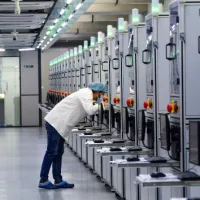
monkeybusinessimages/iStock(NEW YORK) — As the U.S. braces for possible wider spread of the novel coronavirus, health officials are warning business leaders to make preparations for managing a workforce that can’t come into the workplace.
“We’re trying to figure out how to keep the business going when people can’t get to the office,” Peter Cappelli, a professor of management at the Wharton School of the University of Pennsylvania, and the director of Wharton’s Center for Human Resources, told ABC News.
“My sense is the first thing that will happen, and the most likely thing is that it’s not that all your employees will be too sick to work, it’s that they won’t be in the office,” he added.
Coronavirus has already delivered a heavy blow to the business sector, sending global financial markets reeling and bringing economic activity in China — the epicenter of the outbreak and the world’s second largest economy — to a standstill.
The U.S. Centers for Disease Control and Prevention has now warned that “community spread” in the U.S. — spread among individuals where the source of the infection is unknown — is highly likely, and urged Americans to gear up for a “significant disruption.”
As a result, the CDC says that health officials may implement “social distancing measures that increase the physical space between people.”
This may include mandated “workplace social distancing measures” such as “replacing in-person meetings with teleworking,” the U.S. health authorities add.
Managing a massive remote workforce
As confirmed coronavirus cases increase in the U.S., experts say there are small steps that business leaders who want to stay operational amid the outbreak can do now to get ahead of the curve.
The good news for many businesses is that technology has evolved so much in recent years that working remotely doesn’t necessarily have to impact output, and some experts say that working from home can even increase productivity.
Cappelli said employers should start by “figuring out what are our essential jobs, and what are the jobs that have to be done from our office, and how do we think about getting that work done.”
This is “not so obvious by looking at a work chart,” he said, noting that “the people at the top” often end up being “very expendable,” but the “people who are manning certain types of equipment are very, very important.”
“Understanding how vulnerable you are is really a big deal, that starts with what absolutely has to be done in the office versus what has to be done remotely, then thinking about the most-likely threats,” Cappelli said.
In terms of managing a remote workforce, Cappelli said the most important thing is “being clear about performance.”
“One of the things that working remotely makes clear is that if you’re not managing people well, it becomes even more obvious when they’re working remotely,” he said.
“A lot of managers just believe that if someone is home they’re just watching, I Dream of Jeannie all day,” he said. “What that forces you, as a manager, is to think about what do we really want you to do this week, how are we going to see that, how are we going to check in.”
Denise Rousseau, a professor of organizational behavior and public policy at Carnegie Mellon University, told ABC News that now is the time for employers to dust off or design some work-from-home guidelines.
“Be output-focused, not process-focused. Make explicit what expectations are,” Rousseau added of those guidelines.
“Most of these practices are not rocket science, you could run a test for three days and then come out ahead, that’s a way to show you’re calm and competent,” she said.
Rousseau cited a handful of universities in Hong Kong that “are using a capacity they already developed, which is online classes, to do regular classes,” amid the outbreak, and urged businesses to think about what tools and resources they already “already have the capacity to do, that if we do on a broader scale could keep this going.”
A handful of major companies in Asia are also already requiring employees to work remotely amid the outbreak.
While Rousseau acknowledges there may be a “learning curve,” she said that studies have shown that with technology most workers are just as, if not more, productive at home than they are in an office.
Jane Klein, the founder and CEO of Inspire Human Resources, told ABC News she is already preparing for how to manage her team of more than two dozen employees should an outbreak erupt in New York City, and is also advising clients on how to respond to the outbreak.
Klein said the biggest factor in getting ahead of the curve is to make sure that collaborative tools are in place for success, such as teleconferencing software.
“We don’t want to assume that all clients have the tools like Slack, Zoom, Skype etc.,” she said.
“I found that productivity is incredibly high when people work remotely,” she said, adding that many people “get back an hour plus or two and half hours to your day without a commute.”
She noted that tech software such as Trello, Slack and Zoom are very important, but that “like any muscles, it’s all about practicing.”
“What you can do is be realistic about what can be accomplished remote and what can’t,” she said. “Think about security issues — can this be scanned online, does it have to be photocopied and brought home?”
Klein said that ultimately, however, her message to her team is to put their health and their families’ health first. If they choose to not take a flight or do an onsite, “I want to signal to them that it is taken very seriously.”
“When these things happen I think the strongest companies and the strongest leaders lead with comfort and they lead with heart,” she said. “If they are not taking care of these families when these things happen, there is no way they are going to be productive.”
When working remote isn’t an option
For factories, restaurants, retail and more, working from home may not be feasible amid an outbreak.
“I think employers are going to be challenged by the fact that they still have to pay bills during this time, as do employees,” Rousseau told ABC News.
“The biggest problem is factories, where people need to be physically there to get the work done,” she added. “It’s very hard to assemble something at a distance.”
“Those are environments where I think they will be much more burdened to create sanitary conditions,” Rousseau said.
Cappelli reiterated that for manufacturing, service industry jobs and retail, “it’s quite a different exercise” because working remotely cannot be done.
“Retail has the additional problem in that it’s not just your employees that can be sick, all those people coming into your stores that might be sick,” he said. “So if you’re a Walmart or a hotel, what are you going to do? Are you going to shut down? And if not, what are the protocols going to be to keep your employees safe from the customers?”
“Those are policies that we are going to have to start thinking through,” he said.
In the CDC’s interim guidance for businesses and employers to plan and respond to coronavirus, officials recommend companies should first and foremost: “Actively encourage sick employees to stay home.”
The health authorities also urge for companies to perform routine environmental cleaning, especially of all frequently-touched surfaces in the workplace, and to provide disposable wipes so that commonly used surfaces (i.e. doorknobs, keyboards, etc.) can be wiped down by employees before each use.
In these situations where working remotely is not feasible, Rousseau also recommends that leaders look long-term, even if the outbreak is causing temporary harm to the bottom line.
After years of unprecedented growth, Rousseau acknowledges that if a widespread outbreak hits the U.S. “there will be a decline, probably, in shareholder wealth in the short term,” but advises companies to remember: “This will pass.”
Copyright © 2020, ABC Audio. All rights reserved.















